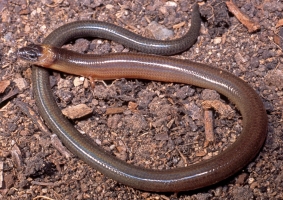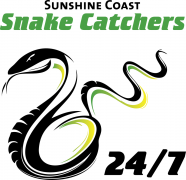
Significance to Humans:
Harmless
General description:
Worm or snake-like in appearance with a long body and short weak limbs, each of which have 3 digits and reduced to clawed stumps in the hindquarters. Brown to grey on the top with a creamy-yellow band across the base of the head. This band is more prominent in juveniles and tends to fade with age.
Distinguished from snake by:
• Presence of movable eyelids
• Fleshy tongue (not forked)
• Fore limbs present
• Hind limbs present although greatly reduced in comparison to fore limbs
• Ear openings
Average length:
300mm with records of individuals in excess of 350mm.
Habitat in SE Qld:
Prefers more humid habitats such as wet sclerophyll forests, rainforest margins, vine thickets and coastal scrubs. Tolerant of habitat disturbance, it thrives in compost heaps and gardens in suburbia, and beneath logs in open paddocks.
General habits:
Verreaux’s Skinks are extremely secretive. Most of their activity takes place under cover, though they are occasionally encountered active above ground at night. When disturbed they quickly burrow into soft soil and compost, slipping through the substrate as easily as an eel through water.
Diet:
Verreaux’s Skinks feed on soil-dwelling invertebrates such as worms, beetle larvae and other small insects.
Local distribution:
One of the most common burrowing skinks in south-east QLD. Successful in all Sunshine Coast suburbs.
Around the home:
Most specimens are found after turning loose soil or grass clippings, discovered by a roaming cat or scurrying from the lawn mower from within long grass. Often found in numbers within prime locations such as compost heaps. They are inoffensive and should simply be released within the confines of your yard in heavy cover such as mulch or under a dense shrub preferably at night.
